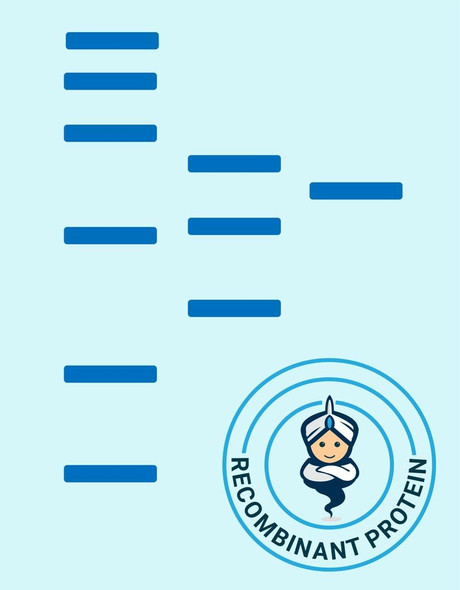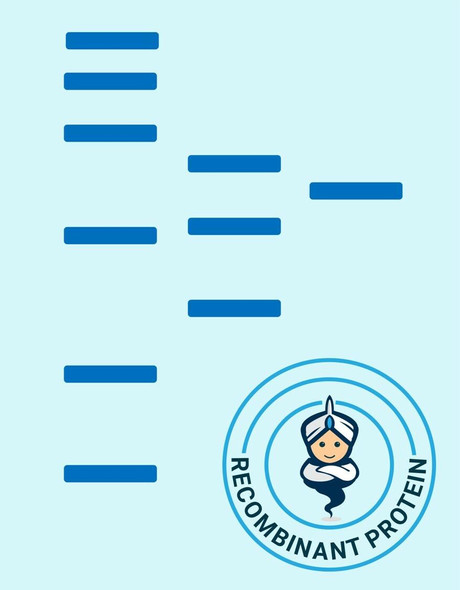Human CETN3 Recombinant Protein (RPPB3153)
- SKU:
- RPPB3153
- Product Type:
- Recombinant Protein
- Species:
- Human
- Uniprot:
- O15182
Description
| Product Name: | Human CETN3 Recombinant Protein |
| Product Code: | RPPB3153 |
| Size: | 20µg |
| Species: | Human |
| Target: | CETN3 |
| Synonyms: | CEN3, CEN-3, CETN-3. |
| Source: | Escherichia Coli |
| Physical Appearance: | Sterile filtered colorless solution. |
| Formulation: | CETN3 Human 0.5mg/ml solution contains 20mM Trsi HCl pH-8, 0.1M NaCl and 10% glycerol. |
| Stability: | Store at 4°C if entire vial will be used within 2-4 weeks. Store, frozen at -20°C for longer periods of time.�For long term storage it is recommended to add a carrier protein (0.1% HSA or BSA).Avoid multiple freeze-thaw cycles. |
| Purity: | Greater than 95% as determined by SDS-PAGE. |
| Amino Acid Sequence: | MGSSHHHHHH SSGLVPRGSH MSLALRSELV VDKTKRKKRR ELSEEQKQEI KDAFELFDTD KDEAIDYHEL KVAMRALGFD VKKADVLKILKDYDREATGK ITFEDFNEVV TDWILERDPH EEILKAFKLF DDDDSGKISL RNLRRVAREL GENMSDEELR AMIEEFDKDG DGEINQEEFI AIMTGDI |
CETN3 comprises of 4 EF-hand calcium binding domains, and is a part of the centrin protein family. CETN3 protein is widely expressed cytoskeletal components that demonstrate increased expression during cell differentiation. CETN3 takes part in centrosome reproduction.
CETN3 Human Recombinant produced in E.Coli is a single, non-glycosylated, polypeptide chain containing 187 amino acids (1-167 a.a.) and having a molecular mass of 21.7 kDa. CETN3 protein is fused to a 20 amino acid His-Tag at N-terminus and purified by standard chromatography.
| UniProt Protein Function: | CETN3: Plays a fundamental role in microtubule-organizing center structure and function. Belongs to the centrin family. |
| UniProt Protein Details: | Chromosomal Location of Human Ortholog: 5q14.3 Cellular Component: centriole; centrosome; nucleolus Molecular Function:calcium ion binding; protein binding Biological Process: cell division; centrosome cycle; mitosis |
| NCBI Summary: | The protein encoded by this gene contains four EF-hand calcium binding domains, and is a member of the centrin protein family. Centrins are evolutionarily conserved proteins similar to the CDC31 protein of S. cerevisiae. Yeast CDC31 is located at the centrosome of interphase and mitotic cells, where it plays a fundamental role in centrosome duplication and separation. Multiple forms of the proteins similar to the yeast centrin have been identified in human and other mammalian cells, some of which have been shown to be associated with centrosome fractions. This protein appears to be one of the most abundant centrins associated with centrosome, which suggests a similar function to its yeast counterpart. Alternatively spliced transcript variants encoding different isoforms have been found for this gene. [provided by RefSeq, Jul 2014] |
| UniProt Code: | O15182 |
| NCBI GenInfo Identifier: | 85567504 |
| NCBI Gene ID: | 1070 |
| NCBI Accession: | AAI12041.1 |
| UniProt Secondary Accession: | O15182,Q53YD2, Q9BS23, |
| UniProt Related Accession: | O15182 |
| Molecular Weight: | 19,550 Da |
| NCBI Full Name: | Centrin 3 |
| NCBI Synonym Full Names: | centrin 3 |
| NCBI Official Symbol: | CETN3�� |
| NCBI Official Synonym Symbols: | CEN3; CDC31�� |
| NCBI Protein Information: | centrin-3 |
| UniProt Protein Name: | Centrin-3 |
| Protein Family: | Centrin |
| UniProt Gene Name: | CETN3�� |
| UniProt Entry Name: | CETN3_HUMAN |










